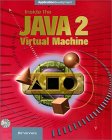|
|
|
Sponsored Link •
|
|
Advertisement
|

The second edition of Bill Venners' Inside the Java Virtual Machine, winner of a 1998 Java Report Writers Choice Award, is now available in bookstores. Inside the Java Virtual Machine explains Java's architecture and internals, and several Java APIs closely tied to the virtual machine, to Java programmers. Reading this book will help you gain a deeper understanding of Java technology, and in the process, help you become more effective at Java programming. This new edition is fully revised for Java 2, and includes much new material on a variety of JVM topics. You can order the book from Amazon by clicking on the image to the right.
|
|
Inside the Java Virtual Machine describes the Java virtual machine, the abstract computer on which all Java programs run, and several Java APIs closely related to the virtual machine. Through a combination of tutorial explanations, working examples, reference material, and applets that interactively illustrate the concepts presented in the text, this book provides an in-depth, technical survey of Java as a technology.
AN INTRODUCTION TO JAVA'S ARCHITECTURE
Chapters 1 through 4 (Part I of the book) give an overview of
Java's architecture, including the motivations behind--and
the implications of--Java's architectural design. These chapters
show how the Java virtual machine relates to the other
components of Java's architecture: the class file, API, and
language. If you want a basic understanding of Java as
a technology, consult these chapters. Here are some
specific points of interest from this portion of the book:
A TUTORIAL OF JAVA INTERNALS
Chapters 5 through 20 (Part II of the book) give an in-depth
technical description of the inner workings of the Java Virtual
Machine. These chapters will help you understand how Java programs
actually work. All the material in Part II is presented in
a tutorial manner, with lots of examples. Here are some
specific points of interest from this portion of the book:
A CLASS FILE AND INSTRUCTION SET REFERENCE INTERACTIVE ILLUSTRATIONS AND EXAMPLE SOURCE CODE The applets directory of the CD-ROM contains an mini-web site, called
the "Interactive Illustrations," that includes 15 Java
applets that illustrate the concepts presented in the text. These
"interactive illustrations" form an integral part of the book.
Eleven of the applets simulate the Java virtual machine
executing bytecodes. The other applets illustrate garbage
collection, two's-complement and IEEE 754 floating point
numbers, and the loading of class files. The applets can be
viewed on any platform by any Java-capable browser. The source
code for the simulation applets is also included on the CD-ROM.
The copyright notice accompanying the HTML, .java, and .class
files for the Interactive Illustrations Web Site enables you to
post the web site on any network, including the internet, providing
you adhere to a few simple rules. For example, you must
post the web site in its entirety, you can't make any changes
to it, and you can't charge people to look at it.
All the example source code shown in the book appears on the
CD-ROM in both source and compiled (class files) form. If some
example code in the text strikes you as interesting (or dubious),
you can try it out for yourself.
Most of the example code is illustrative and not likely to be of
much practical use besides helping you to understand Java.
Nevertheless, you are free to cut and paste from the example
code, use it in your own programs, and distribute it in
binary (such as Java class file) form.
JVM RESOURCES Some Fascinating Details About the Book What the Press is Saying
In addition to being a tutorial on the Java class file, Chapter
6, "The Java Class File," serves as a complete reference of the
class file format. Similarly, Chapters 10 through 20 form a
tutorial of the Java virtual machine's instruction set, and
Appendices A through C serve as a complete reference of the
instruction set. If you need to look something up, check out these
chapters and the appendices.
For most of the book's chapters, material associated with the
chapter--such as example code or simulation applets--appears on
the CD-ROM.
To help you find more information and keep abreast of changes, the
author maintains a "Resources Page" with links to further reading
about the material presented in the book.
|
Sponsored Links
|